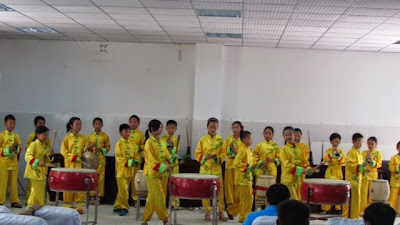We drove about 2.5 hours Southwest from Chongqing to a beautiful and serene "rural" area called Qijang. I put the term rural in quotations because the population of this area is a whopping 960,000 and the high school we visited is home to almost 7,000 students and teachers. Everything is relative here in China and the Zhonghua village we visited after lunch did seem more rural than the part of town where the school is located. I didn't think it was possible to get any hotter, but I was wrong!
The schools we visited have entrance exams and are very competitive. Most of the students in attendance come from surrounding areas and are the children of the growing migrant worker class. They study hard and sometimes, especially prepping for the gaokao college entrance exam in their senior year, they may be at school and studying way into the wee hours of the night. Getting placed in a university in China is similar to American Medical School residency programs-you can list your preferences, but ultimately the Chinese government and the universities will pick you and you have no final say in the matter. Performing well on the exam and getting into a good school is one's only hope of fulfilling your parent's dreams of escaping the hard life of a struggling migrant. Many families are split up as students live on campus at most of the good schools...while their parents travel from city to city lookig for work or stay at home in a smaller town to farm the land.
When we first arrived we met students and they practiced their English with us. School was already out for summer, but they came back just to welcome us. They were so sad to see us go and both sides waved goodbye until we were no longer in sight.
She is an art teacher too! You can see the work of her talented high school students below...
School grounds...
After lunch, we visited the Qijang #1 Experimental Primary School. The experimental part is that they are trying out more student centered, small group questioning type teaching methods like we use in the states; as opposed to the typical lecture style teaching more common in China. The school is similar in concept to a magnet or gifted school back home. They encourage use of the fine arts (drama, music, visual art, etc...) to make learning more engaging for the students. Sounds like arts integration to me! :)
The kids performed a scene from Mulan. They were beautiful and so was their English!
After the performance, some of them shared their hobbies and interests with us...
She and her teacher collaborated to make this ornate costume with recycled milk cartons.
After visiting the primary school, we drove a little further into the countryside...many students come from this area...
Kids performing a traditional percussion and horn show. This musical tradition has been passed down through families for 18 generations. It dates back over 300 hundred years!
Some of us learn how to play Mahjong...
Grinding beans to make fresh tofu
Spices out in preparation for dinner...
View on the ride back


























































